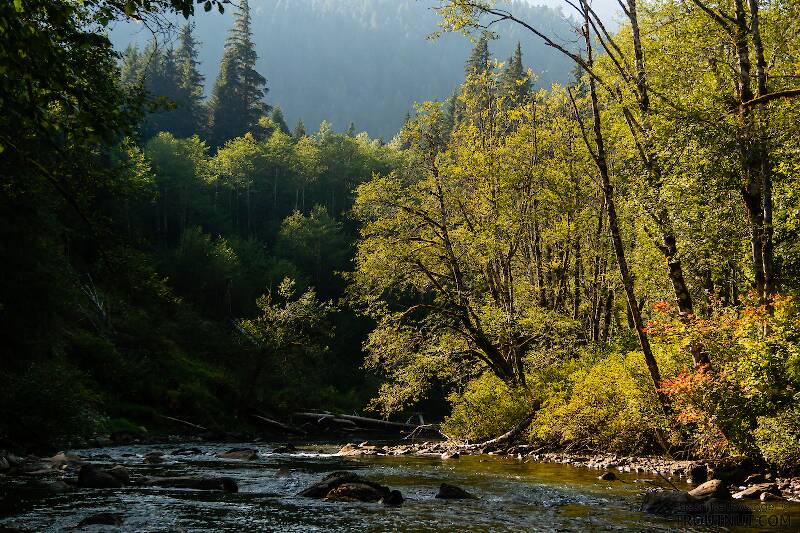
Salmonflies
Pteronarcys californica
The giant Salmonflies of the Western mountains are legendary for their proclivity to elicit consistent dry-fly action and ferocious strikes.
Featured on the forum

As far as I can tell, this species has only previously been reported from one site in Oregon along the Columbia gorge. However, the key characteristics are fairly unmistakable in all except for one minor detail:
— 4 small yellow spots on frons visible in photos
— Narrow occipital spinule row curves forward (but doesn’t quite meet on stem of ecdysial suture, as it's supposed to in this species)
— Short spinules on anterior margin of front legs
— Short rposterior row of blunt spinules on abdominal tergae, rather than elongated spinules dorsally
I caught several of these mature nymphs in the fishless, tiny headwaters of a creek high in the Wenatchee Mountains.
— 4 small yellow spots on frons visible in photos
— Narrow occipital spinule row curves forward (but doesn’t quite meet on stem of ecdysial suture, as it's supposed to in this species)
— Short spinules on anterior margin of front legs
— Short rposterior row of blunt spinules on abdominal tergae, rather than elongated spinules dorsally
I caught several of these mature nymphs in the fishless, tiny headwaters of a creek high in the Wenatchee Mountains.

Troutnut is a project started in 2003 by salmonid ecologist Jason "Troutnut" Neuswanger to help anglers and
fly tyers unabashedly embrace the entomological side of the sport. Learn more about Troutnut or
support the project for an enhanced experience here.
Stonefly Genus Allocapnia (Little Snowflies)
Allocapnia granulata is the most abundant Capniidae species in the East.
Where & when
In 615 records from GBIF, adults of this genus have mostly been collected during March (29%), February (26%), January (20%), December (11%), and April (10%).
In 82 records from GBIF, this genus has been collected at elevations ranging from 125 to 4856 ft, with an average (median) of 3182 ft.
Genus Range
Discussions of Allocapnia
Little Black Stonefly pics
12 replies
Posted by Adirman on Apr 14, 2018 in the species Allocapnia granulata
Last reply on Apr 21, 2018 by Martinlf
Hey guys, went out on the Neversink for awhile today and had a look around, saw a lot of little dark flies, may be the little black stone fly? Hard to tell cuz looked like Caddis too. Looks like about a size 16? Any pics of available of this species would be great.
Thanks
Thanks
Start a Discussion of Allocapnia
Stonefly Genus Allocapnia (Little Snowflies)
Taxonomy
Species in Allocapnia
Allocapnia auroraAurora Snowflies
0
0
Allocapnia cunninghamiKarst Snowflies
0
0
Allocapnia curiosaPeculiar Snowflies
0
0
Allocapnia forbesiThree-knobbed Snowflies
0
0
Allocapnia frumiMonongahela Snowflies
0
0
Allocapnia granulataLittle Snowflies
0
0
Allocapnia harperiStonyfork Snowflies
0
0
Allocapnia indianaeIndiana Snowflies
0
0
Allocapnia mariaTwo-knobbed Snowflies
0
0
Allocapnia minimaBoreal Snowflies
0
0
Allocapnia mysticaMoraine Snowflies
0
0
Allocapnia nivicolaBrook Snowflies
0
0
Allocapnia ohioensisOhio Snowflies
0
0
Allocapnia ozarkanaOzark Snowflies
0
0
Allocapnia pechumaniSt. Lawrence Snowflies
0
0
Allocapnia perplexaPerplexing Snowflies
0
0
Allocapnia polemistisBlack Warrior Snowflies
0
0
Allocapnia pygmaeaPygmy Snowflies
0
0
Allocapnia rickeriMidwest Snowflies
0
0
Allocapnia sandersoniNotched Snowflies
0
0
Allocapnia smithiThree-lobed Snowflies
0
0
Allocapnia stannardiBlueridge Snowflies
0
0
Allocapnia unzickeriCumberland Snowflies
0
0
Allocapnia virginianaVirginiana Snowflies
0
0
Allocapnia zolaAsh Snowflies
0
0
Species in Allocapnia: Allocapnia aurora, Allocapnia cunninghami, Allocapnia curiosa, Allocapnia forbesi, Allocapnia frumi, Allocapnia granulata, Allocapnia harperi, Allocapnia indianae, Allocapnia maria, Allocapnia minima, Allocapnia mystica, Allocapnia nivicola, Allocapnia ohioensis, Allocapnia ozarkana, Allocapnia pechumani, Allocapnia perplexa, Allocapnia polemistis, Allocapnia pygmaea, Allocapnia rickeri, Allocapnia sandersoni, Allocapnia smithi, Allocapnia stannardi, Allocapnia unzickeri, Allocapnia virginiana, Allocapnia zola
16 species (Allocapnia brooksi, Allocapnia frisoni, Allocapnia fumosa, Allocapnia illinoensis, Allocapnia jeanae, Allocapnia loshada, Allocapnia malverna, Allocapnia mohri, Allocapnia oribata, Allocapnia peltoides, Allocapnia recta, Allocapnia simmonsi, Allocapnia tennessa, Allocapnia vivipara, Allocapnia warreni, and Allocapnia wrayi) aren't included.

